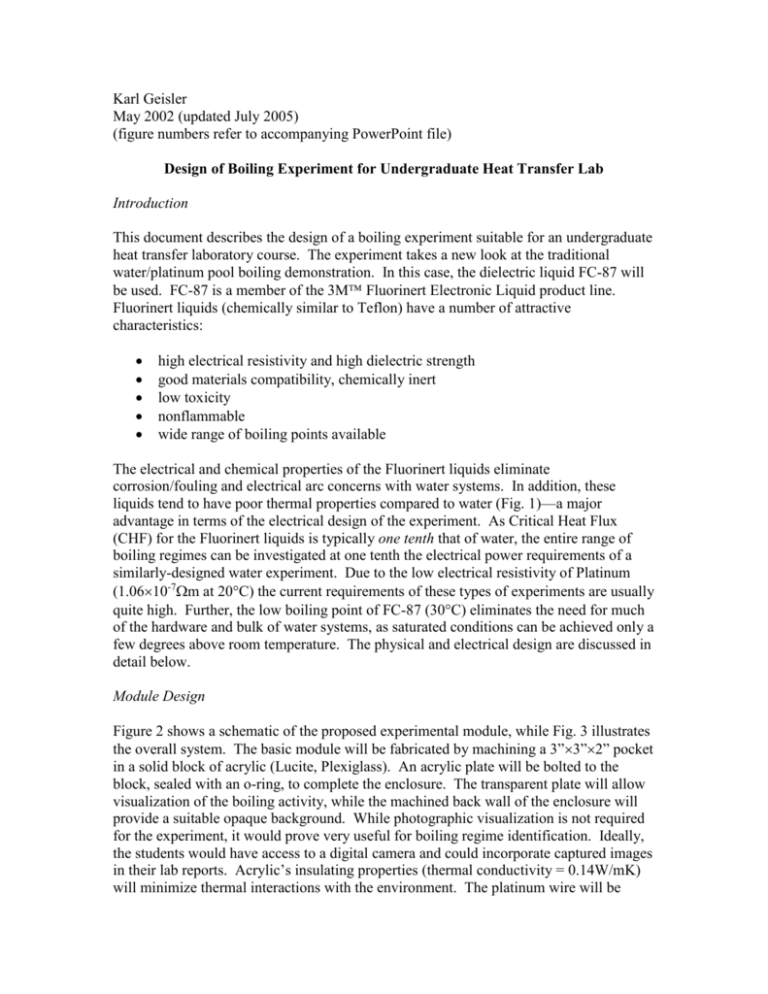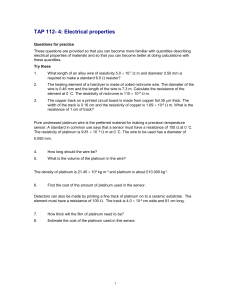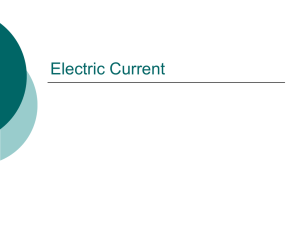boilingexperimentdesign
advertisement

Karl Geisler May 2002 (updated July 2005) (figure numbers refer to accompanying PowerPoint file) Design of Boiling Experiment for Undergraduate Heat Transfer Lab Introduction This document describes the design of a boiling experiment suitable for an undergraduate heat transfer laboratory course. The experiment takes a new look at the traditional water/platinum pool boiling demonstration. In this case, the dielectric liquid FC-87 will be used. FC-87 is a member of the 3M Fluorinert Electronic Liquid product line. Fluorinert liquids (chemically similar to Teflon) have a number of attractive characteristics: high electrical resistivity and high dielectric strength good materials compatibility, chemically inert low toxicity nonflammable wide range of boiling points available The electrical and chemical properties of the Fluorinert liquids eliminate corrosion/fouling and electrical arc concerns with water systems. In addition, these liquids tend to have poor thermal properties compared to water (Fig. 1)—a major advantage in terms of the electrical design of the experiment. As Critical Heat Flux (CHF) for the Fluorinert liquids is typically one tenth that of water, the entire range of boiling regimes can be investigated at one tenth the electrical power requirements of a similarly-designed water experiment. Due to the low electrical resistivity of Platinum (1.0610-7m at 20C) the current requirements of these types of experiments are usually quite high. Further, the low boiling point of FC-87 (30C) eliminates the need for much of the hardware and bulk of water systems, as saturated conditions can be achieved only a few degrees above room temperature. The physical and electrical design are discussed in detail below. Module Design Figure 2 shows a schematic of the proposed experimental module, while Fig. 3 illustrates the overall system. The basic module will be fabricated by machining a 3”3”2” pocket in a solid block of acrylic (Lucite, Plexiglass). An acrylic plate will be bolted to the block, sealed with an o-ring, to complete the enclosure. The transparent plate will allow visualization of the boiling activity, while the machined back wall of the enclosure will provide a suitable opaque background. While photographic visualization is not required for the experiment, it would prove very useful for boiling regime identification. Ideally, the students would have access to a digital camera and could incorporate captured images in their lab reports. Acrylic’s insulating properties (thermal conductivity = 0.14W/mK) will minimize thermal interactions with the environment. The platinum wire will be supported by two brass rods. These rods will be fastened to a small acrylic “cap,” allowing possible rod separations (wire lengths) of 1, 2, and 3cm. The bulk liquid temperature will be measured by a thermocouple. A lamp with a standard 100W light bulb, placed close to the front of the module, can be used to heat the module to the saturation temperature of the liquid. (The liquid saturation temperature is only a few degrees above room temperature.) This lamp can be located behind the module during the experiments to help maintain the liquid temperature and assist with bubble visualization. A water-cooled condenser will be connected to the module to recondense vapor generated during the experiment and minimize evaporative losses. The condenser can be cooled by cold tap water. The physical design of the module will allow horizontal and vertical wire orientations by simply rotating the entire system 90 (Fig. 2 clockwise). Electrical Design The physical dimensions of the wire and the electrical resistivity of platinum drive the electrical design of the experiment. Given the expected resistivity range of 110-7 to 1.510-7m, a wire diameter of 0.010” (0.254mm), and basic electrical relations, the wire can be expected to dissipate 0-4W of power (heat) with supplied voltages and currents ranging 0-1V and 0-10A, respectively. (A similar water experiment would require 2030A of current at the upper limit.) A digital DC power supply is recommended for supplying precisely-controlled electrical power to the wire. An accurate voltmeter will be needed to measure the power supply voltage as well as the voltage drop across the shunt resistor to calculate the supply current. Parts/Components List The following table shows the parts and materials needed to construct the proposed experiment. FC-87 acrylic module condenser type-t thermocouple liquid heaters brass rods miscellaneous wire and hardware platinum wire Omega #SPPL-010 0.010” diameter platinum wire www.omega.com 10A shunt resistor such as Empro Shunts #HA-20-50 Type HA DC Ammeter Shunt Empro Mfg. Co., Inc. (317) 823-4478 www.emproshunts.com sales@emproshunts.com main power supply (0-1V, 0-10A) voltmeter thermocouple voltage reader/ice reference light source camera (if desired)








